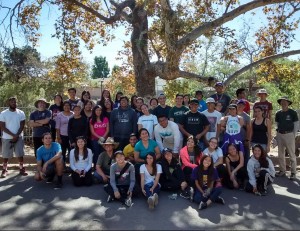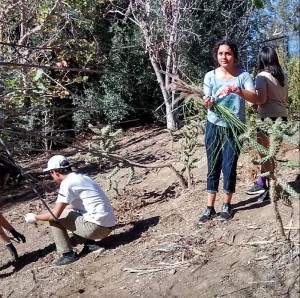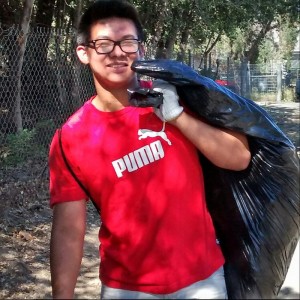Local high school students say farewell to fountain grass at Halloween volunteer event.
By Darrell King, BTN Communications Intern
 On Halloween volunteers from Santiago High School National Honor Society in Garden Grove, CA assisted Back to Natives by digging up tons of fountain grass, an invasive species that harms the environment in Santiago Park.
On Halloween volunteers from Santiago High School National Honor Society in Garden Grove, CA assisted Back to Natives by digging up tons of fountain grass, an invasive species that harms the environment in Santiago Park.
Originally native to Africa and the Middle East, fountain grass was introduced because of its popularity as an ornamental plant. In California it is spreading (by vehicles, humans, wind, and water) along the coast from the San Francisco Bay Area to Baja California. It endangers native plant communities and raises fuel loads increasing the intensity and spread of fire.
Students broke up in groups, and began digging up fountain grass for three hours.
One person pulled out the grass, while others placed them in trash bags.
 When 17-year-old Santiago High School student Tony Nguyen was asked to describe his experience in a few words, his response was playful, but firm, “Hardwork,” Nguyen said smiling.
When 17-year-old Santiago High School student Tony Nguyen was asked to describe his experience in a few words, his response was playful, but firm, “Hardwork,” Nguyen said smiling.
While the work was somewhat strenuous, volunteers enjoyed the experience. “I really liked it. I love the smell here, and how we’re just here with nature,” 17-year-old Emily Huynh said. “I liked the event. I hope I can come back sometime,” Huynh added.
Students were appreciative of Back to Natives Executive Director Reginald Durant.
“He’s very nice, and helpful. He’s extremely experienced about native plants.” 17-year-old Marina Zaky said.
“They showed us what to do. We could easily follow their instructions. I would volunteer again. I just have to make sure to bring my water,” Nguyen joked.
 Durant didn’t just teach the students the art of digging up fountain grass, he explained why their work was important, then joined the volunteers in the trenches, showing his commitment to restoring habitat.
Durant didn’t just teach the students the art of digging up fountain grass, he explained why their work was important, then joined the volunteers in the trenches, showing his commitment to restoring habitat.
“Thick infestations of fountain grass interfere with regeneration of native plant species,” said Durant. “Fountain grass is difficult to eliminate – it can reproduce by either fertilized or unfertilized seeds, and seeds may remain viable in the soil for at least seven years. The work these students are doing here today is essential.”
To volunteer with Back to Natives please visit our volunteer webpage for upcoming opportunities.
